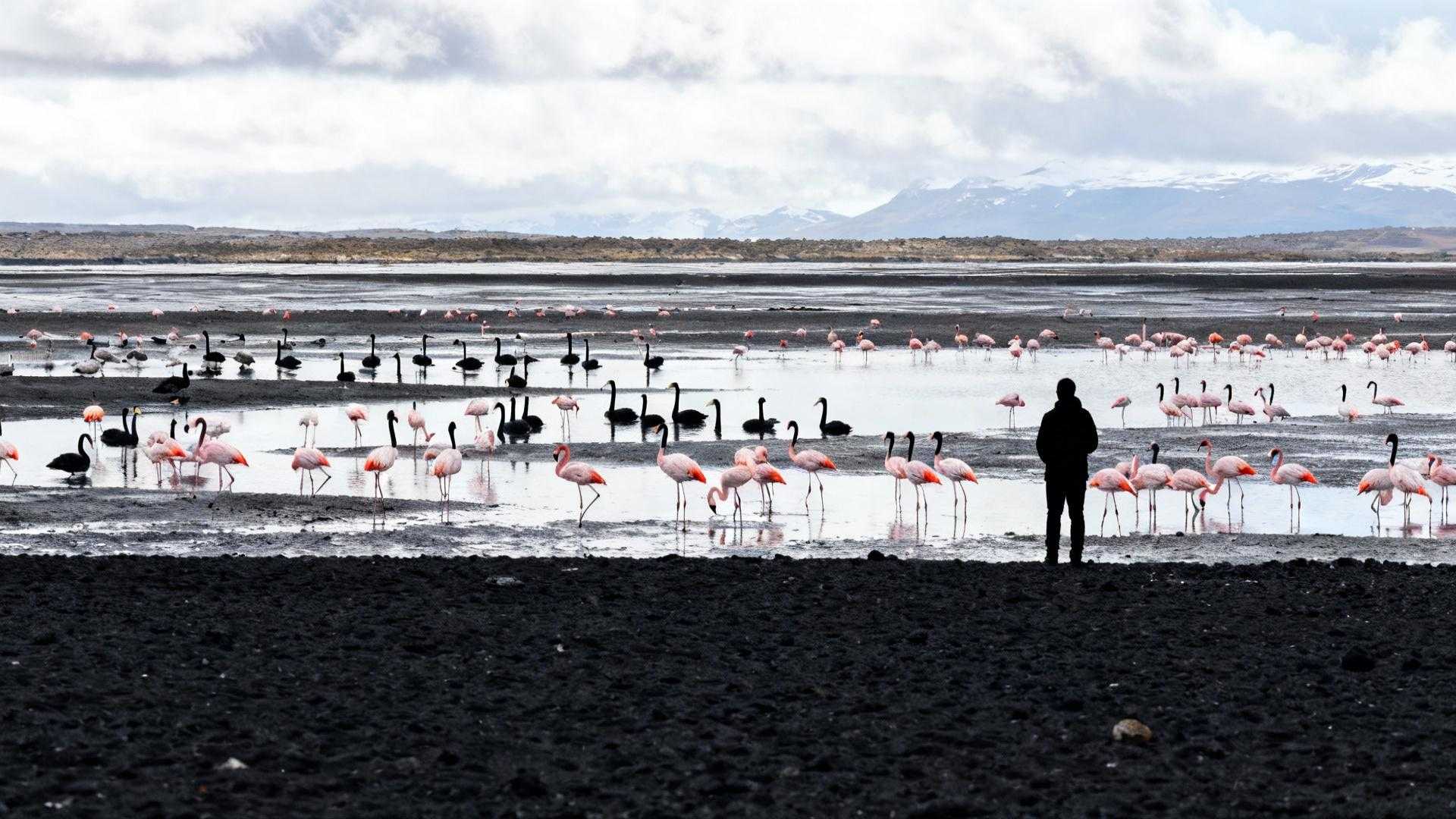I’ll never forget the moment I stood on Caulín Bay’s black volcanic sand at dawn, watching the tide retreat to reveal what locals call their santuario sagrado—sacred sanctuary. As the Pacific withdrew across Chiloé Island’s eastern shore, thousands of pink flamingoes materialized from the mist alongside elegant black-necked swans, creating a convergence that exists nowhere else on Earth with this precise combination of species, tidal drama, and indigenous protection.
This is the only coastal bay in Chile where more than 60 migratory bird species gather during 6-hour tidal windows, and the Huilliche community has spent generations ensuring it stays that way.
What makes Caulín truly singular isn’t just the spectacle—it’s the ecological accident that created it. When the 2004 Río Cruces disaster displaced Chile’s black-necked swan populations, these endangered birds discovered Chiloé’s sheltered marine wetlands offered something their traditional freshwater habitats couldn’t: protection from industrial contamination and year-round feeding grounds enriched by extreme tidal exchanges.
The tidal miracle that concentrates wildlife like nowhere else
How 6-hour cycles create feeding frenzies
Caulín Bay’s extreme tides retreat nearly one kilometer twice daily, exposing mudflats teeming with mollusks, crustaceans, and marine invertebrates. This creates feeding windows so rich that 1,500 black-necked swans converge here during summer months—one of Chile’s largest concentrations of this endangered species. Scientific studies documented 47 active nests on nearby Lacaos Island alone, with nest construction beginning each July and first hatchings in September.
The flamingo phenomenon that defies expectations
While most travelers associate Chilean flamingos with northern Atacama salt flats, Caulín hosts thousands of specimens during fall and winter when these pink waders migrate south seeking coastal feeding grounds. Unlike the Atacama’s harsh desert environment, Chiloé’s temperate bay offers sheltered waters and abundant food sources that support extended stays. The contrast between graceful flamingoes and stocky black-necked swans creates visual drama that wildlife photographers travel continents to capture.
The species diversity that makes biologists jealous
Rare families converging in single habitat
Beyond swans and flamingoes, Caulín hosts documented populations of Scolopacidae sandpipers and Rynchopinae skimmers—specialized bird families rarely observed together. The bay’s unique position where Pacific currents meet sheltered archipelago waters creates ecological conditions supporting everything from diving ducks to wading herons. Local guides can identify species by silhouette alone during morning feeding hours when the bay transforms into an avian buffet.
The ecosystem shift that saved a species
After industrial pollution devastated Carlos Anwandter Nature Sanctuary’s swan population—which crashed from 22,419 birds in 2020 to just 2,782 by 2022—Chiloé’s marine wetlands became critical refuge habitat. Caulín Bay now represents evolutionary adaptation in real-time, as swans shifted from exclusive freshwater living to coastal environments offering greater resilience against environmental threats.
The Huilliche protection that keeps tourism sustainable
Traditional practices that safeguard habitats
The Huilliche community practices sustainable fishing and agriculture that coexists with bird populations through centuries-old ecological knowledge. Their January Bird Sanctuary Festival isn’t tourism marketing—it’s cultural celebration teaching younger generations why protection matters. When extreme low tides expose shellfish beds during la mariscada seafood festivals, locals harvest with strict limits ensuring regeneration for both human communities and bird populations.
The access philosophy that prevents overtourism
While Torres del Paine National Park 800 kilometers south battles 150,000 annual visitors paying $35 entry fees, Caulín charges nothing for beach access and offers local boat tours for $25. Similar to how Puerto Rico’s Mosquito Bay protects bioluminescence through visitor limits, Caulín’s community-controlled tourism prevents the habitat degradation that destroyed other Chilean wetlands.
The seasonal windows that demand strategic timing
March to May for flamingo spectacles
Plan visits during austral fall migration periods when pink flamingoes arrive in peak numbers alongside resident swan populations. Morning low tides offer optimal photography light as feeding activity peaks and mist creates atmospheric backdrops against Chiloé’s green hills.
July to September for swan nesting drama
Witness endangered species reproduction during austral winter breeding season when black-necked swans construct nests and hatch cygnets. The Huilliche approach mirrors how Canada’s Ojibwa communities integrate tourism with traditional ecology—visitors observe without disturbing critical life cycles.
Access Caulín via 3-hour drive and ferry from Puerto Montt, where basic Spanish helps but isn’t essential. The sanctuary’s future depends on continued community stewardship and travelers willing to experience wildlife without demanding infrastructure that destroys what makes places sacred.
Your questions about Caulín Bay answered
When do both swans and flamingoes appear together?
Brief overlap occurs during March-April transition periods when summer swan populations haven’t fully departed and early fall flamingo arrivals begin. However, peak concentrations occur separately—swans dominate December through February, flamingoes peak May through August.
How does Caulín compare to Patagonia’s famous wildlife sites?
Caulín offers 80% fewer crowds, zero entry fees, and equally dramatic wildlife encounters within easier reach of Puerto Montt’s airport. While Torres del Paine requires advance permits and battles overtourism, Caulín’s community-controlled access maintains authentic experiences.
What makes the bird diversity scientifically significant?
The coexistence of specialized families like Scolopacidae and Rynchopinae in single coastal habitat creates research opportunities for ornithologists studying species adaptation to marine environments. Black-necked swan breeding in saltwater represents evolutionary shift documented through ongoing scientific studies.
